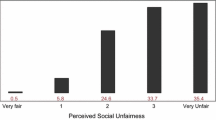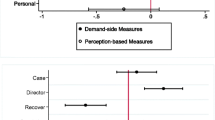Abstract
This research investigates the determinants of attitudes toward corruption in China using micro-level data. We use survey data on 6000 individuals from 28 provinces to estimate logit models that show how individual and provincial determinants shape attitudes toward corruption. Respondents who have higher education, belong to higher social class, live in rural areas, and are members of the Communist Party of China, think corruption is less useful than the other respondents. Negative attitude toward corruption is related to higher education, lower social class, and membership in the Communist Party of China.
Similar content being viewed by others
Change history
12 April 2019
Due to an unfortunate oversight the author name Ilari Määtta has been misspelt. It should be read Ilari Määttä.
Notes
In comparison, the corruption perception index provided by Transparency International is based on opinions of business people and analysts, and assesses how wide respondents think that corruption is.
Data analyzed in this paper were collected as part of the research project “China General Social Survey (CGSS),” which was carried out by the National Survey Research Center, Renmin University of China (NSRC). The authors appreciate Center’s assistance in providing the data.
We also tried estimations by including Age and Age² to test a possible nonlinear relation between age and corruption variables, but Age² is not significant.
See Song (2014) for developments on the hukou system in China.
We also perform estimations with the size of the mining sector, measured by the share of total workers in the mining sector, following its use by Dong and Torgler (2013). Nevertheless, this variable is not significant in any estimations. We do not include this variable in the final estimations because of its high collinearity with the Gini coefficient.
We have also used an ordered probit model. Our results are not affected by the model choice.
References
Ades, A., and R. Di Tella. 1999. Rents, Competition and Corruption. American Economic Review 89 (4): 982–993.
Anderson, C.J., and Y.V. Tverdova. 2003. Corruption, Political Allegiances, and Attitudes Toward Government in Contemporary Democracies. American Journal of Political Science 47 (1): 91–109.
Bian, Y., and L. Li. 2012. The Chinese General Social Survey (2003–8): Sample Designs and Data Evaluation. Chinese Sociological Review 45 (1): 70–97.
Cabelkova, I. 2001. Perceptions of Corruption in Ukraine: Are They Correct?. CERGE-EI working paper series number 176, Charles University, Prague. .
Cabelkova, I., and J. Hanousek. 2004. The Power of Negative Thinking: Corruption Perception and Willingness to Bribe in Ukraine. Applied Economics 36: 383–397.
Donchev, D., and G. Ujhelyi. 2014. What Do Corruption Indices Measure? Economics and Politics 26 (2): 309–331.
Dong, B., and B. Torgler. 2013. Causes of Corruption: Evidence from China. China Economic Review 26: 152–169.
Fisman, R., and Y. Wang. 2015. Corruption in Chinese Privatizations. Journal of Law Economics and Organization 31 (1): 1–29.
He, Z. 2000. Corruption and Anti-Corruption in Reform China. Communist and Post-Communist Studies 33 (2): 243–270.
Jong-Sung, Y., and S. Khagram. 2005. A Comparative Study of Inequality and Corruption. American Sociological Review 70 (1): 136–157.
Manion, M. 2004. Corruption by Design: Building Clean Government in Mainland China and Hong Kong. Cambridge: Harvard University Press.
Melgar, N., M. Rossi, and T.W. Smith. 2010. The Perception of Corruption. International Journal of Public Opinion Research 22 (1): 120–131.
NBSC. 2015. China Statistical Yearbook Database. National Bureau of Statistics of China, Available at: http://www.stats.gov.cn/english/statisticaldata/AnnualData/. Accessed 11 Nov 2015.
Quah, J.S.T. 2013. Minimizing Corruption in China: Is This an Impossible Dream? Maryland Series in Contemporary Asian Studies, 2013 (4): 1.
Rabl, T. 2011. The Impact of Situational Influences on Corruption in Organizations. Journal of Business Ethics 100 (1): 85–101.
Rabl, T., and T. Kühlmann. 2008. Understanding Corruption in Organizations. Journal of Business Ethics 82 (2): 477–495.
Ramirez, C.D. 2014. Is Corruption in China ‘Out of control’? A Comparison with the US in Historical Perspective. Journal of Comparative Economics 42: 76–91.
Rose-Ackerman, S. 1997. The Political Economy of Corruption. In Corruption and the Global Economy, ed. K.A. Elliott, 31–60. Washington: Institute for International Economics.
Sapio, F. 2005. Implementing anticorruption in the PRC: Patterns of selectivity. Working paper No. 10, Centre for East and South-East Asian Studies, Lund University, Lund.
Serra, D. 2006. Empirical Determinants of Corruption: A Sensitivity Analysis. Public Choice 126: 225–256.
Smyth, R., and J. Qian. 2009. Corruption and Left-Wing Beliefs in a Post-Socialist Transition Economy: Evidence from China’s ‘Harmonious Society’. Economics Letters 102: 42–44.
Song, Y. 2014. What Should Economists Know About the Current Chinese Hukou System? China Economic Review 29: 200–212.
Torgler, B., and N. Valev. 2010. Gender and Public Attitudes Toward Corruption and Tax Evasion. Contemporary Economic Policy 28 (4): 554–568.
Wedeman, A. 2012. Double Paradox: Rapid Growth and Rising Corruption in China. Ithaca: Cornell University Press.
World Bank. 2015. Helping Countries Combat Corruption: The Role of World Bank. The World Bank Group, Available at: http://www1.worldbank.org/publicsector/anticorrupt/corruptn/cor02.htm#note1. Accessed 20 Aug 2018.
Zhan, J.V. 2012. Filling the Gap of Formal Institutions: The Effects of Guanxi Network on Corruption in Reform-Era China. Crime Law and Social Change 58 (2): 93–109.
Zhu, J., J. Lu, and T. Shi. 2013. When Grapevine News Meets Mass Media: Different Information Sources and Popular Perceptions of Corruption in Mainland China. Comparative Political Studies 46 (8): 920–946.
Acknowledgements
We acknowledge the comments from the two anonymous referees.
Author information
Authors and Affiliations
Corresponding author
Additional information
Publisher's Note
Springer Nature remains neutral with regard to jurisdictional claims in published maps and institutional affiliations.
The original version of this article was revised: the author name has been given incorrect.
Rights and permissions
About this article
Cite this article
Fungacova, Z., Määttä, I. & Weill, L. Corruption in China: What Shapes Social Attitudes Toward It?. Comp Econ Stud 61, 493–518 (2019). https://doi.org/10.1057/s41294-018-00083-8
Published:
Issue Date:
DOI: https://doi.org/10.1057/s41294-018-00083-8




